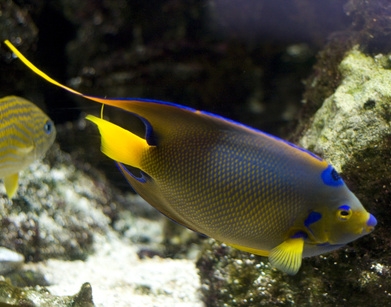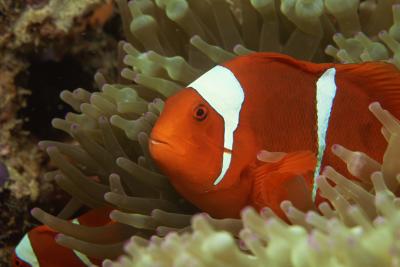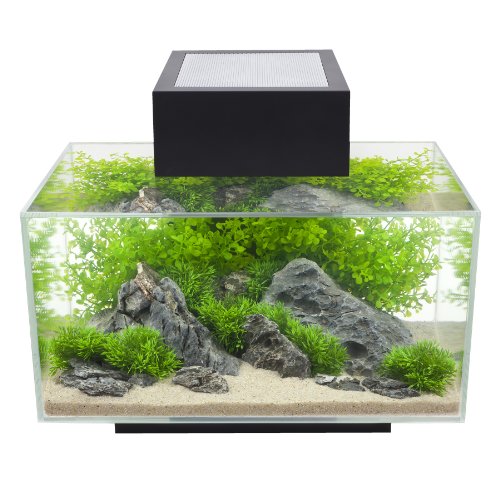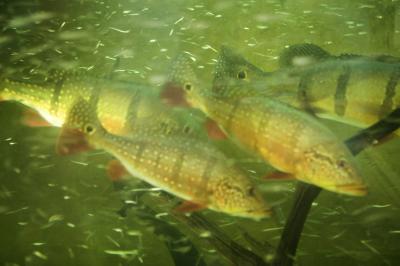What color is your Goldfish?

Goldfish. Goldfish? Really? A “gold” fish? Of course I’m talking about the ubiquitous fish that we all know and most of us have had in our lives at one point or another. I have fond memories of going to the carnival that came to town and seeing hundreds of these little fish in tiny glass bowls. We would spend a dollar or two to get a chance to toss ping-pong balls into the bowls to win a fish. We would covet the ones that weren’t completely “gold”, but instead had white or black markings. Why were they different?

The Goldfish is a member of the Carp family Cyprinidae and the scientific name is Carassius auratus. They are the domesticated version of a small wild fish (
Carassius Geibelio) still found in slow-moving waters in Southern China and this relationship with man goes back over 1600 years. The original wild carp (image below) is actually drab (brown) in color and through selective breeding over hundreds of years, many color varieties have emerged, such as black, silver, gold, and even fish of the spotted variety. Though it appears that a goldfish gets its coloration from its scales, the color actually comes from pigment in the skin underneath the scales. The scales are transparent. Selective breeding has removed the pigmentation found in the original wild fish.
 Goldfish Color Varieties
Goldfish Color VarietiesGoldfish varieties are typically grouped by the amount of reflective material contained in the skin. They can be metallic (full amount of reflective material), nacreous or calico (lacking some reflective material), or matt (with no reflective material). Within each of these groups, different color varieties are now available in several “standardized” colors. The gold variety can range in color from “yellow-gold” to “orange-gold”. The black variety ranges from a “dark-bronze” all the way to a deep, velvety “flat-black”. This variety is also known as a “Moor” and has protruding eyes. Completely white fish are also available and they glimmer like silver. Mottled or “Calico” fish can be found and these fish are usually gold and white with black spotting. Fish with red markings on the head or “red heads” are also readily available. There are also special strains such as the “Panda” variety, which are black, white, and yellow. Goldfish can be found in any of the above color combinations. They can also be found with different body types, such as “fantail” or “lion-head”, so there’s a “Goldfish” for every taste.
 Goldfish Color Change?
Goldfish Color Change?A lot of these color varieties are actually transitional colors. That young fish that you won at the carnival will probably look like a completely different color as an adult. Black is particularly transitional and most of the time it will fade to reveal gold or bronze underneath. Red also can fade to gold as the fish matures. The Black Moor in the photos (above) changed from a deep black to a dark brown within eight months. The other fish (below) was completely silver-white with a bright red-head (Red-Cap Oranda variety). Much to my dismay, also during the next eight months, orange-gold began to emerge making it look like a completely different fish! Water temperature and color-enhancing food that’s available at most pet stores may accelerate a color change. Goldfish are long-lived fish (10-20 years is not unusual), so there is a lot of time this to occur.

So, what color is your “Gold” fish? It probably isn’t the color you think it is, or at least not for long. The big irony is that if your “Gold” fish Abraham found his way back into the wild, he and his offspring, through “natural selection” and just a few generations, would revert back to the original drab color of their ancestors. So much for hundreds of years of careful breeding.


 The Goldfish is a member of the Carp family Cyprinidae and the scientific name is Carassius auratus. They are the domesticated version of a small wild fish (Carassius Geibelio) still found in slow-moving waters in Southern China and this relationship with man goes back over 1600 years. The original wild carp (image below) is actually drab (brown) in color and through selective breeding over hundreds of years, many color varieties have emerged, such as black, silver, gold, and even fish of the spotted variety. Though it appears that a goldfish gets its coloration from its scales, the color actually comes from pigment in the skin underneath the scales. The scales are transparent. Selective breeding has removed the pigmentation found in the original wild fish.
The Goldfish is a member of the Carp family Cyprinidae and the scientific name is Carassius auratus. They are the domesticated version of a small wild fish (Carassius Geibelio) still found in slow-moving waters in Southern China and this relationship with man goes back over 1600 years. The original wild carp (image below) is actually drab (brown) in color and through selective breeding over hundreds of years, many color varieties have emerged, such as black, silver, gold, and even fish of the spotted variety. Though it appears that a goldfish gets its coloration from its scales, the color actually comes from pigment in the skin underneath the scales. The scales are transparent. Selective breeding has removed the pigmentation found in the original wild fish. 


 Signs of a Sick Fish
Signs of a Sick Fish
Signs of a Sick F
Signs of a Sick Fish
Signs of a Sick Fish
Signs of a Sick F
 Clown Fish Small Tank Set Up for Beginners
Clown Fish Small Tank Set Up for Beginners
Clown Fish Small Tank Set Up for Beginners
Clown Fish Small Tank Set Up for Beginners
 Setting Up a Saltwater Aquarium
A saltwater aquarium is a lo
Setting Up a Saltwater Aquarium
A saltwater aquarium is a lo
 Cloudy Eyes on Aquarium Fish
Cloudy Eyes on Aquarium Fish
Cloudy Ey
Cloudy Eyes on Aquarium Fish
Cloudy Eyes on Aquarium Fish
Cloudy Ey
 Dangers of the Deep
While many believe there is
Dangers of the Deep
While many believe there is